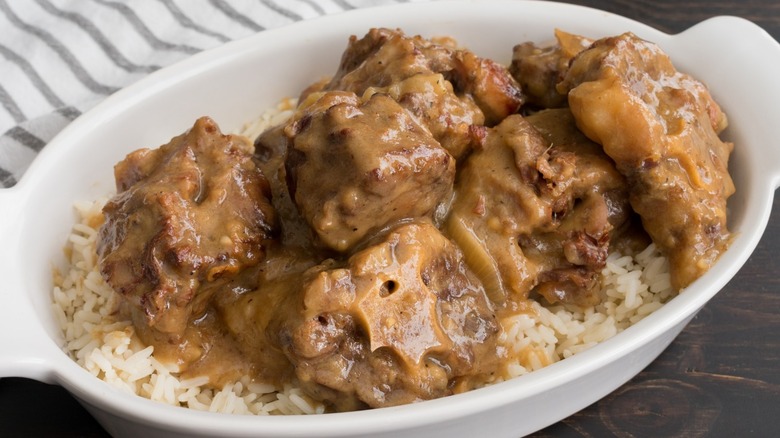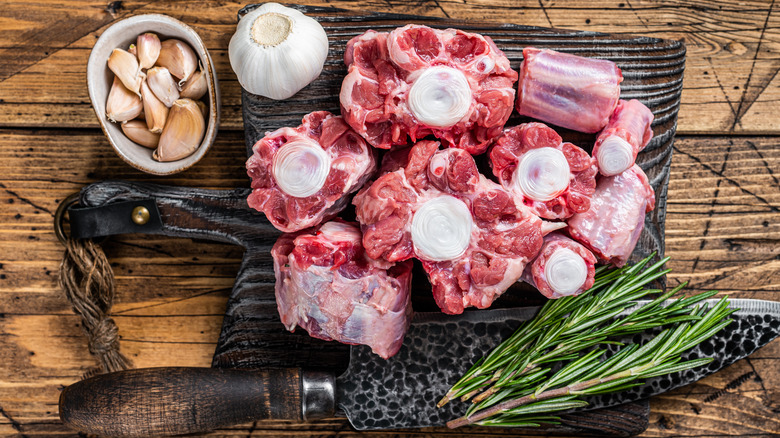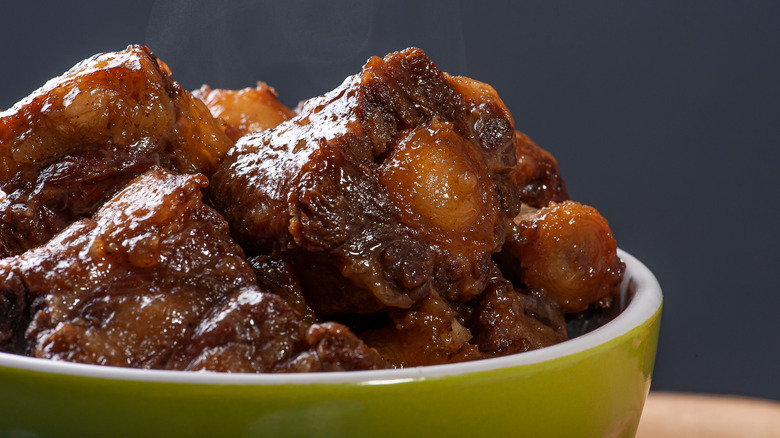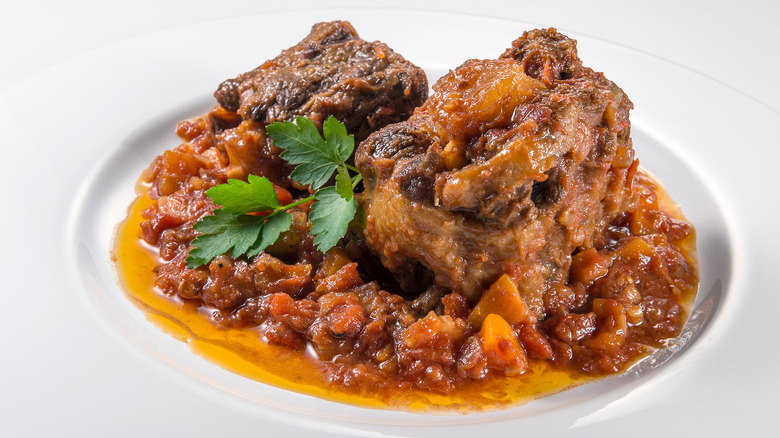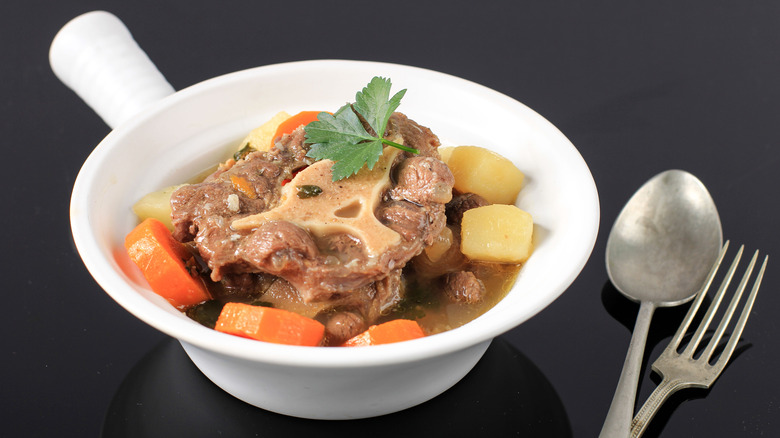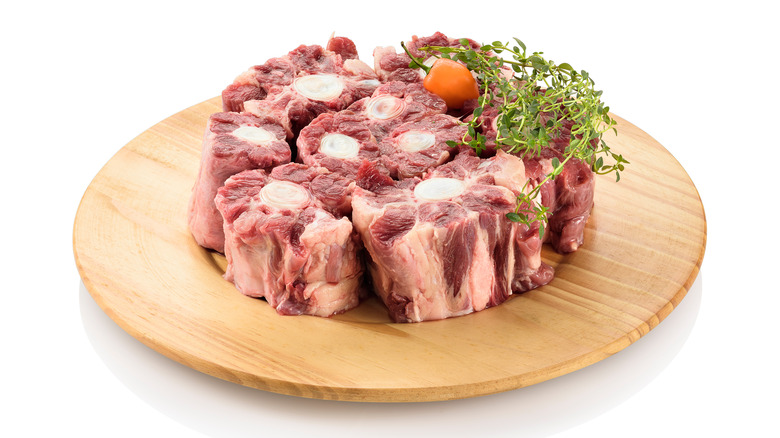What Is Oxtail And How Do You Cook It?
If you've ever had the opportunity to eat oxtail, then you know: it's delicious. But while it's a pretty common main ingredient in some cultures, it's not nearly as well-known among a majority of Americans.
The Spruce Eats gives us the scoop, explaining that oxtail comes from the tail cut of beef from a cow of either gender. Before being wrapped up and being sent to the grocery store or market, the tail's skin is taken off, and the tail itself gets butchered into round pieces of meat, which prominently features a section of bone in the middle. Because this part of the cow is rich in connective tissue, oxtail has high levels of collagen and naturally thickens soups, stews, and braises with gelatin when it is cooked. It's a humble cut that can become a magnificent dish when cooked properly.
Where does oxtail meat come from?
According to the Los Angeles Times, the cooking of oxtail can be traced to the use of oxen as beasts of burden, which was common all over the Old World as well as some parts of the Americas. Oxen, today known as "steers," are more docile and therefore more suitable to be used as work animals. Formerly, when the animal came to the end of its working life and was slaughtered for food, people discovered that oxen were not only milder in temperament but also tastier than bulls. For that reason, although oxen (steers) are generally no longer used as work animals, the practice of castrating male cows for the beef market continues today.
Back in the day, when nose-to-tail eating was a given and every single part of the animal was used, folks developed recipes to utilize oxtail, generally in long-cooked dishes that broke down the tail's connective tissue to produce a rich broth (via The Spruce Eats).
What does oxtail taste like?
If you like beef, you'll love oxtail. Deeply meaty with an abundance of flavor, oxtail can be compared to short rib, but when cooked it can actually be even more tender than that cut, says The Spruce Eats. Much of oxtail's deliciousness is thanks to the section of bone at the center of each round; because the bone is cut crosswise, each section contains a hearty knob of marrow, per The Takeout. As the oxtail cooks, the fat-rich marrow melts, bathing each piece of meat and lending its buttery, nutty taste to the dish as a whole.
Although it may be an unlikely candidate for gorgeous photos, this special cut of meat has actually made it to Reddit for just that: Ase u/chabernet noted alongside a beautiful shot, "Oxtails sound gross but the taste is amazing." Many commenters agreed. "I had oxtail for the first time last year, and it was incredible. It's a little like eating the tenderest, most flavourful ribs you can find," one user added. "Nothing better than properly tender oxtail," another concurred.
What dishes to cook with oxtail
As cattle are found all over the world, it should come as no surprise that dishes containing oxtail are common in cuisines across the globe. One dish that immediately comes to mind is Jamaican oxtail stew, which is also enjoyed in other nations in the Caribbean and often features soft butter beans and spicy Scotch bonnet peppers (via The New York Times). Jessica B. Harris, author of the cookbook "High on the Hog: A Culinary Journey from Africa to America," noted in Saveur, "You know it's a real traditional meal in the English-speaking Caribbean when you are presented with a dish of fragrant oxtail stew. The slow-cooked dish is always dense with flavor and 'more-ish,' meaning a second helping is the norm."
Meanwhile, Romans like to make coda alla vaccinara — a braised oxtail dish with tomatoes, celery, and warming spices — while Eastern Europeans enjoy the cut in barley soup with a side of rye bread. Of course, The Spruce Eats points out that since oxtails are mostly bones with a little bit of meat, people like to use the bones and marrow to make beef stock as a base for soups and stews. As you've probably deduced, oxtail needs to be cooked slowly so the tough meat can break down into a melt-in-your-mouth texture.
Nutritional information about oxtail
Due to its high amounts of bone marrow, oxtail is a relatively fatty meat, containing about 14 grams of fat and 260 calories per 100-gram serving, according to Livestrong. According to the Weston A. Price Foundation, bone marrow is an extremely valuable fat, boasting an excellent source of fat-soluble vitamins and minerals that made it a prized nutritional ingredient among Native Americans and other cultures. More than a third of oxtail's fat is saturated, and recent research suggests that saturated fat can support liver health and balance hormones, per Greatist. Oxtail is also a good source of protein, providing about 30 grams per serving.
Because it is rich in collagen, oxtail is known among certain cultures for being excellent for skin, nail, and hair health. According to Soffli, the Korean oxtail soup called kori gomtang is famed for brightening, tightening, and clearing the skin. To reap the benefits of its collagen, you can also prepare and sip bone broth that's heavy on the oxtail.
Why is oxtail so expensive?
For much of its culinary history, oxtail was considered a "throwaway" meat, a scrap not fit for the higher echelons of society. According to the National Collaborating Centre for Environmental Health, the cuisine we today call soul food originated during the era of slavery in the United States, when African slaves "were given only leftovers and the parts of animals that the plantation owners didn't eat, such as pig's feet and ears, ham hocks, hog jowls," and oxtails, which found their way into spicy stews or into a brown gravy served over rice. Prior to its more recent culinary renaissance, butchers used to sell oxtail for pennies on the pound so they wouldn't have to throw it away at the end of the day, reports The Spruce Eats.
More recently, thanks to the nose-to-tail movement among chefs and home cooks alike, oxtail has become more and more popular — and its price has risen as a result. Today, a pound of oxtail will cost you $5 to $10, depending on the quality of the meat, says Prepared Cooks. Experiment by going to supermarkets, butcher shops, and specialty Asian and other international grocers to find the best prices.
